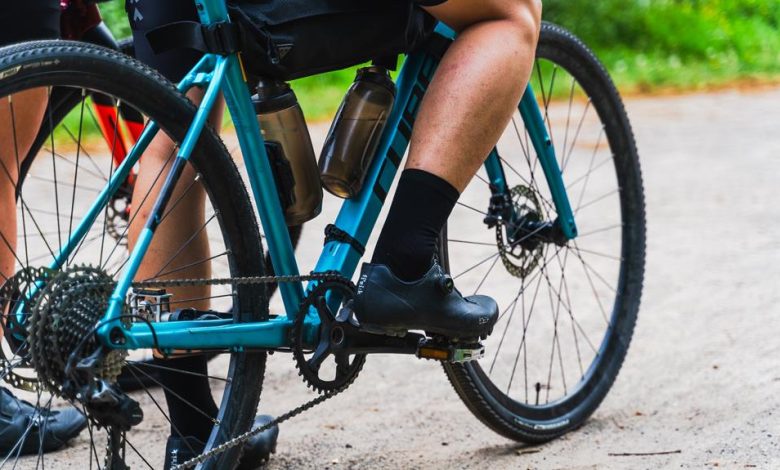Unleash Your Inner Gravel Cyclist

Are you ready to unleash your inner gravel cyclist? Get ready to embark on an exciting adventure that will take you off the beaten path and onto the rugged terrain of gravel roads. In this article, we'll explore what it means to be a gravel cyclist and the unexpected differences you'll encounter compared to traditional road cycling. But first, let's answer the question on everyone's mind: what the heck is a gravel bike? Let's dive in and discover the world of gravel cycling together.
Key Takeaways
- Gravel cycling offers a sense of adventure and thrill.
- The right gear enhances the gravel riding experience.
- Regular training enhances physical and mental resilience in gravel cycling.
- Proper nutrition and hydration optimize performance and enjoyment.
Understanding the Gravel Cycling Phenomenon
If you frequently ride on gravel roads or trails, you may have noticed the growing popularity of gravel cycling. It's a phenomenon that has taken the cycling world by storm, with more and more riders embracing the thrill and adventure of riding on unpaved surfaces. One of the reasons for this surge in popularity is the rise of gravel cycling events. These events not only provide an opportunity for riders to challenge themselves and showcase their skills, but they also foster a sense of community and camaraderie among participants. Another benefit of gravel cycling that shouldn't be overlooked is its positive impact on mental health. The combination of being out in nature, the physical exertion, and the sense of accomplishment can do wonders for reducing stress and improving overall well-being. So, if you're looking for a new cycling experience that offers both excitement and mental rejuvenation, give gravel cycling a try. You won't be disappointed.
Essential Gear for Gravel Riding
When it comes to gravel riding, you'll definitely want to invest in some essential gear to enhance your experience. One of the most important aspects is choosing the right gravel bike. Look for a bike that has wider tires, a more relaxed geometry, and disc brakes for better control on rough terrain. A few must-have accessories for gravel riding include a comfortable helmet to protect your head, a hydration pack to keep you fueled and hydrated during long rides, and a good pair of gloves for added grip and protection. Additionally, consider investing in a reliable bike computer to track your mileage and performance, and don't forget to bring a multitool and spare tubes in case of any mechanical issues on the road. With the right gear, you'll be ready to tackle any gravel adventure with confidence and enjoyment.
Mastering the Art of Gravel Cycling
To truly master the art of gravel cycling, you'll need to embrace the challenge and push yourself outside of your comfort zone. It's not just about having the right gear and equipment; it's about honing your skills and becoming one with the gravel. Let's explore some essential gravel cycling techniques and gravel bike maintenance tips to help you unleash your inner gravel cyclist.
| Gravel Cycling Techniques | Gravel Bike Maintenance |
|---|---|
| Body Position | Regular Cleaning |
| Cornering | Lubrication |
| Braking | Tire Pressure |
| Climbing | Brake Pad Replacement |
Gravel cycling techniques like proper body position, cornering, braking, and climbing are crucial for navigating the unpredictable terrain. Mastering these techniques will not only make you a more confident and efficient rider but also help prevent accidents. Additionally, regular bike maintenance is essential to ensure your gravel bike is in top shape. Regular cleaning, lubrication, and checking tire pressure are some of the key maintenance tasks. Don't forget to replace brake pads when necessary to maintain optimal stopping power. By honing your techniques and taking care of your bike, you'll be well on your way to becoming a master of gravel cycling.
Training Techniques for Gravel Cyclists
To improve your performance as a gravel cyclist, try incorporating interval training sessions and hill repeats into your workout routine. These training techniques are essential for building endurance and strength on the unpredictable terrain that gravel cycling demands. Interval training involves alternating between periods of high-intensity effort and recovery, simulating the demands of gravel cycling. This method helps improve your cardiovascular fitness and ability to sustain high speeds over long distances. Hill repeats, on the other hand, focus on building leg strength and power, crucial for conquering the challenging climbs that gravel routes often present. By regularly incorporating these training techniques into your routine, you'll develop the physical and mental resilience needed to excel in gravel cycling. So lace up your shoes, hop on your bike, and let the training begin!
Fueling Your Body for Gravel Adventures
To fully enjoy your gravel adventures, make sure you fuel your body with the right nutrition. Gravel cycling can be demanding, so it's essential to provide your body with the energy it needs to conquer those rough terrains. Here are some nutrition tips and hydration strategies to keep you going strong:
- Fuel up before your ride: Start with a balanced meal containing carbohydrates, protein, and healthy fats. This will provide sustained energy and prevent hunger during your ride.
- Hydrate properly: Drink plenty of water before, during, and after your gravel adventure. Consider adding electrolyte-enhanced drinks to replenish lost minerals.
- Snack smartly: Pack easy-to-digest snacks like energy bars, bananas, and trail mix. These will provide quick energy boosts and keep you fueled throughout your ride.
Safety Measures Every Gravel Cyclist Should Know
Stay vigilant and prioritize safety as you embark on your gravel cycling adventures. Gravel cycling can be thrilling and challenging, but it also comes with its own set of risks. To ensure a safe and enjoyable ride, there are some essential safety measures every gravel cyclist should know.
First and foremost, always wear a helmet. It may seem like common sense, but it's surprising how many cyclists neglect this basic safety precaution. A helmet can protect your head in the event of a fall or collision, potentially saving your life.
Another important safety measure is to be visible. Use lights and reflective gear, especially if you're riding in low-light conditions or at night. This will make you more visible to other road users, reducing the risk of accidents.
Additionally, be mindful of your surroundings and ride defensively. Gravel roads can be unpredictable, with loose rocks, potholes, and other obstacles. Keep your eyes on the road ahead and be prepared to react quickly. Maintain a safe distance from other cyclists and vehicles, and always signal your intentions to communicate with others on the road.
Lastly, don't forget to fuel your body properly. Gravel cycling can be physically demanding, so it's important to maintain proper nutrition and hydration. Pack snacks and plenty of water to keep your energy levels up throughout your ride.
Exploring the Best Gravel Routes Near You
Check out the local gravel maps to discover the best routes for your next adventurous ride. Exploring off road cycling trails is a thrilling way to connect with nature and challenge yourself on two wheels. Here are some gravel route recommendations to get you started:
- The Scenic Loop: This route takes you through picturesque countryside, with stunning views of rolling hills and meandering rivers. It's a perfect blend of challenging terrain and breathtaking scenery.
- The Forest Escape: Dive into the depths of nature on this route that winds through dense forests and tranquil streams. You'll feel a sense of peace and serenity as you pedal through the lush greenery.
- The Mountain Challenge: For those seeking a true test of their skills, this route offers steep climbs, exhilarating descents, and jaw-dropping vistas from the mountain peaks. It's a ride that will leave you breathless and wanting more.
Overcoming Challenges on the Gravel Path
With perseverance and determination, you can conquer any obstacles that come your way on the gravel path. Overcoming challenges on the gravel path requires not only physical strength, but also mental fortitude. It's normal to encounter doubts and fears when faced with unfamiliar terrain, but remember that you have the power to overcome them. Push through those mental barriers and embrace the thrill and excitement of gravel cycling.
In addition to mental barriers, proper gravel bike maintenance is crucial to ensure a smooth and enjoyable ride. Regularly check your tire pressure, as it can greatly impact your bike's handling on gravel surfaces. Inspect your bike for any signs of wear and tear, such as loose bolts or worn-out brake pads. Keep your chain clean and lubricated to enhance its performance and prevent rust. By taking care of your bike, you'll be better equipped to tackle the challenges that come your way on the gravel path. So, gear up, stay determined, and unleash your inner gravel cyclist!
Unleashing Your Inner Gravel Racing Potential
Maximize your gravel racing potential by incorporating interval training into your weekly cycling routine. Interval training is a key component of gravel racing techniques, helping to improve your speed, power, and endurance on the challenging terrain. Here are some ways to unleash your inner gravel racer:
- Mix it up: Incorporate high-intensity intervals into your rides, alternating between periods of hard effort and recovery. This will simulate the demands of gravel racing and push your limits.
- Mental preparation: Gravel racing requires mental toughness and resilience. Practice visualization techniques to mentally prepare yourself for the unpredictable nature of the race. Stay focused and embrace the challenges along the way.
- Train on similar terrain: Seek out gravel roads or off-road trails to train on. Familiarize yourself with the different surfaces and conditions you may encounter during a race. This will build confidence and improve your bike handling skills.
Embracing the Joy of Gravel Cycling
Feel the exhilaration of riding along the rugged gravel paths, embracing the freedom and adventure of gravel cycling. There's nothing quite like the feeling of conquering challenging terrain and exploring the great outdoors on your gravel bike. But gravel cycling is not just about the physical challenge; it's also about the joy and thrill that comes with it.
When you're out on the gravel roads, you're not just riding alone. You're part of a community of like-minded individuals who share the same passion for adventure and exploration. Gravel cycling brings people together, whether it's through group rides, races, or online forums. It's a chance to connect with others who understand the thrill of pushing your limits and embracing the unknown.
To give you a taste of the community aspect of gravel cycling, here's a table that highlights some of the ways you can find and connect with fellow gravel cyclists:
| Community Building Activities | Benefits |
|---|---|
| Group rides | Opportunity to learn from experienced riders and make new friends |
| Gravel cycling events | Chance to challenge yourself, meet other riders, and discover new routes |
| Online forums and social media groups | Platform to share experiences, ask questions, and get advice from the gravel cycling community |
| Local gravel cycling clubs | Access to organized rides, clinics, and a supportive network of fellow gravel enthusiasts |
Frequently Asked Questions
What Are the Benefits of Gravel Cycling Compared to Other Forms of Cycling?
Gravel cycling offers unique benefits compared to other forms of cycling. It's a fantastic way to improve your physical fitness, as it challenges your muscles and cardiovascular system on rough terrains. Moreover, it provides mental well-being, allowing you to disconnect from the hustle and bustle of daily life and reconnect with nature. Lastly, gravel cycling allows you to explore new terrains, discovering hidden gems and experiencing the thrill of venturing off the beaten path.
Are There Any Specific Maintenance Requirements for Gravel Bikes?
Gravel bikes are awesome, but they require some specific maintenance to keep them in tip-top shape. There are a few essential bike maintenance tasks you should know about. First, regularly clean and lubricate your drivetrain to keep it running smoothly. Second, check your tire pressure before every ride to ensure optimal performance. Third, inspect your bike for any signs of wear and tear, and address them promptly. By taking care of these maintenance tasks, you'll be able to enjoy your gravel bike to the fullest.
How Can I Improve My Bike Handling Skills for Gravel Riding?
To improve your bike handling skills for gravel riding, practice is key. Start by finding a safe and open space where you can practice maneuvering your bike. Focus on maintaining a balanced and relaxed body position, as this will help you navigate the unpredictable terrain. Work on your cornering technique by leaning your bike into turns and keeping your weight centered. Remember to keep your eyes up and scan the trail ahead for potential obstacles. With time and practice, your gravel riding techniques will improve, allowing you to confidently unleash your inner gravel cyclist.
What Are Some Common Mistakes That Beginners Make When Starting Gravel Cycling?
Common mistakes beginners make when starting gravel cycling include not properly preparing for the unique challenges of off-road riding and neglecting to invest in the right gear. To avoid these errors, focus on training tips such as building endurance and improving bike handling skills. Additionally, ensure you have essential gear like a gravel bike, helmet, and appropriate clothing. By being prepared and knowledgeable, you can unleash your inner gravel cyclist and enjoy the thrilling and adventurous world of gravel riding.
Are There Any Specific Strategies or Techniques for Tackling Different Types of Gravel Surfaces?
When it comes to tackling different types of gravel surfaces, tire selection and body positioning are key. You might be wondering, "How do I know which tires to choose?" Well, it all depends on the type of gravel you'll be riding on. For loose or muddy surfaces, wider tires with more aggressive tread patterns are ideal. As for body positioning, keeping your weight centered and your elbows slightly bent will help you maintain control and maneuverability. So get out there and conquer those gravel roads with confidence!



